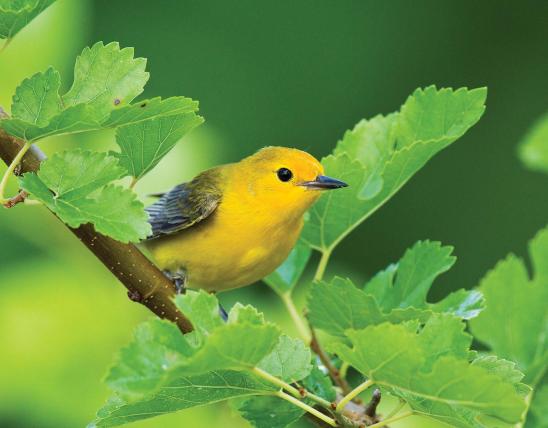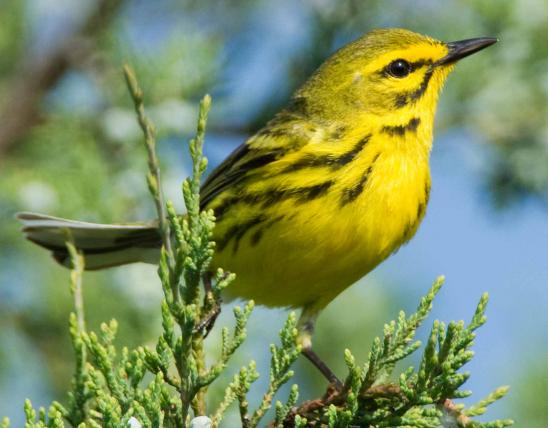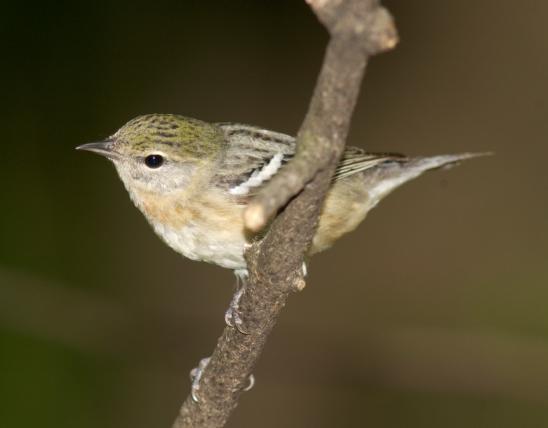
The upperparts of the yellow-throated warbler are gray, with a black cap, eye line, and cheek. The two wing bars, bold eyebrow line, and patch on side of neck are white. Adult underparts are white, with black streaks along sides and flank, and a bright yellow throat and upper breast. The song, frequently given from the top of a sycamore tree, is a descending, accelerating series, a clear, whistled cheew cheew cheew cheew tew-tew-tew twee, with a rising note at the end. The call is a strong chirp.
Similar species: Other summer resident warblers with gray backs are the northern parula (lacks white eyebrow and black cheek); female American redstart (no defined streaks or other marks); cerulean warbler (no yellow); prothonotary warbler (has all-yellow head); and blue-winged warbler (has yellow head with thin black eye line). Female and immature Blackburnian warblers are similar, but they have yellow or buffy (not white) eyebrow lines, plus they have pale mantle stripes on the back; also, they are uncommon transients in Missouri, not summer residents. Another warbler, the common yellowthroat, has a confusingly similar name, but it looks quite different: its back is olive, lacking wing bars, the underparts are yellow, and the male’s face has a prominent black mask.
Length: 5½ inches.

Most common in the southeastern third of Missouri (comprising the Ozarks and Mississippi Lowlands), rarer elsewhere, and mostly absent from the far northwestern corner.
Habitat and Conservation
This is another warbler that you will probably hear before you see. Learn its distinctive song, go to likely habitat in the spring, and bring binoculars! Yellow-throated warblers spend most of their time in the tops of trees, foraging and nesting. In our part of the country, they prefer forests along streams and rivers, especially in sycamore trees, and are also found in upland mixed pine-oak forests and bald cypress wetlands.
Food
Creeps along branches in the tops of trees, searching under the bark and in bark crevices for insects and spiders.
Status
Common summer resident. Rare in the Glaciated Plains and outside the forested Ozark region. Genus name: This and nearly 30 other wood-warblers used to be in the genus Dendroica, but evidence from genetic research showed that that genus could not logically be kept separate from genus Setophaga. Today, all the Dendroica warblers are now in genus Setophaga.
Life Cycle
One of our summer resident warblers, this species is present in Missouri from late March through early September. They breed in treetops, building cup nests from a variety of mosses, grasses, feathers, weeds, and lined with feathers, plant down, and other soft materials. Clutches comprise 3–5 eggs, which are apparently incubated 12–13 days. Breeding details are not well-known, because these treetop-nesting birds are difficult to observe. There can be 1 or 2 broods. Winters are spent along the Gulf Coast and south into Central America. A yellow-throated warbler can live to be at least 5 years old.
Human Connections
Bird watching, which for some is almost a competitive sport, employs both sight and hearing. Birders mark “H” on their species checklists when they have heard a bird but haven’t seen it. Many birders no doubt have only an “H” marked on their checklist beside the name “yellow-throated warbler”!
Ecosystem Connections
Often, we are scarcely aware of what goes on high above our heads, but a tremendous variety of insects live in the tops of trees. This bird helps to keep the populations of these insects in check. This warbler is one of many birds whose breeding range may be disrupted by climate change in the coming century.


About 350 species of birds are likely to be seen in Missouri, though nearly 400 have been recorded within our borders. Most people know a bird when they see one — it has feathers, wings, and a bill. Birds are warm-blooded, and most species can fly. Many migrate hundreds or thousands of miles. Birds lay hard-shelled eggs (often in a nest), and the parents care for the young. Many communicate with songs and calls.
































